Application of Shannon Entropy to Reaction–Diffusion Problems Using the Stochastic Finite Difference Method
Abstract
1. Introduction
2. Deterministic Model
3. A Stochastic Process Approach
- expected value
- variance
- autocovariance
- autocorrelation
- autocorrelation coefficient
4. Reaction–Diffusion with Uncertainty
- the zeroth order partial differential equation
- the nth-order partial differential equation
- the zeroth equation
- the linear recursive equation for each next perturbation order k
5. Numerical Illustration
6. Concluding Remarks
- I.
- As documented above, Shannon entropy may serve as some additional uncertainty quantification and propagation measure close to the coefficients of variation not only in steady-state but also in non-stationary problems with random coefficients. It should be noted that the analysis of coefficients of variation provides precise information about the nature of the process at a given time point, enabling the assessment of the relative dispersion of random values at specific spatiotemporal locations. In contrast, Shannon entropy can serve as a complementary measure for uncertainty quantification and propagation, offering a more global insight into the process dynamics. Unlike the local characteristics described by coefficients of variation, entropy captures the trend of uncertainty propagation over time and space, both in steady-state and non-stationary problems involving random coefficients. As such, it represents a valuable tool for the comprehensive analysis of complex processes in which the distribution of uncertainty evolves significantly over the course of the system’s development. Although the determination of Shannon entropy demands the application of the Monte Carlo simulation, it gives accumulated knowledge about uncertainty propagation, which in probabilistic moments-based analysis follows the graphs of expectations and second-order statistics. It has also been shown that an application of the symbolic algebra environment enables a solution of the generalized stochastic-perturbation-based discrete equations’ system as well as for an introduction of the perturbation parameter ε into the final solution expansions and the resulting probabilistic moments. Thanks to the very extensive linear algebra tools in MAPLE 2025 (as well as in other symbolic computation systems), we can efficiently implement the stochastic perturbation scheme using the response function method [27]. This approach relies on constructing low-order polynomial approximations of the system response with respect to uncertain input parameters and enables analytical computation of output probabilistic moments. As a result, we obtain a compact and flexible framework that is compatible with both symmetric and non-symmetric coefficient matrices, and capable of handling nonlinear effects due to input uncertainty.
- II.
- The numerical analysis presented here demonstrates that Shannon entropy systematically decreases over time, indicating a progressive reduction in uncertainty and increased spatial uniformity of the concentration field. The highest entropy values are observed near the boundary, suggesting localized disorder at the system’s edge. Simultaneously, the coefficient of variation stabilizes rapidly, with initially elevated values diminishing significantly as the system evolves. This convergence highlights the decreasing influence of stochastic fluctuations and the growing regularity of the solution. The consistency between entropy and variance-based indicators confirms that Shannon entropy serves as a reliable measure of uncertainty and information content in stochastic diffusion–reaction processes. These findings support the utility of entropy-based diagnostics in identifying spatial zones of increased randomness and guiding the analysis of complex transport phenomena. Numerical results presented above also indicate that the system evolves towards a steady state, where concentration differences are minimized, and both entropy and the coefficient of variation decrease over time. The initially high entropy and variance highlight the presence of dynamic mixing processes and stochastic fluctuations, which gradually diminish, leading to a more deterministic concentration distribution. These findings confirm that the stochastic modeling approach effectively captures the initial uncertainty within the system and its subsequent reduction as diffusion progresses, providing a robust framework for analyzing reaction–diffusion dynamics in uncertain environments.
- III.
- The generalized stochastic finite difference method seems to be the efficient probabilistic computational tool to model the reaction–diffusion problems with random parameters and time series and should be further developed for unsteady problems, and also for inhomogeneous domains [32] in 2D or 3D [29]. As was demonstrated above, this method can be applied to problems with physical (mechanical or chemical) parameters having some stochastic boundary waviness, although essentially more complicated situations with multiple randomness sources may also be modeled. It has been shown that the stochastic methodology described above may also be applied directly to the implementations of the FDM on irregular grids [33] or combined with some meshless techniques [34]. Further comparative studies against the Monte Carlo simulation programs may give a direct answer concerning the precision of the perturbation-based SFDM in problems that have some input parameters defined as time series with random coefficients.
- IV.
- Although the proposed stochastic finite difference method (SFDM) shows promising results for linear and stationary reaction–diffusion problems, its extension to more realistic, nonlinear, and time-dependent systems remains a significant challenge. In such cases, several numerical difficulties must be addressed, i.e., nonlinearities often introduce stiffness and sensitivity to perturbations, which can severely constrain the choice of discretization parameters. Similarly, time-dependent problems impose additional stability conditions on the numerical scheme, resulting in high computational costs for long-time simulations. To overcome these challenges, future versions of the SFDM should incorporate implicit integration techniques, which are known to offer superior stability properties for stiff systems. Furthermore, adaptive time-stepping strategies could be employed to dynamically control the temporal resolution depending on the rate of change in the system. These enhancements, while increasing computational complexity, would allow the method to handle more general classes of reaction–diffusion systems, including those with strong nonlinearity and spatial heterogeneity.
Author Contributions
Funding
Institutional Review Board Statement
Data Availability Statement
Conflicts of Interest
References
- Collatz, L.C. The Numerical Treatment of Differential Equations; Springer: Berlin, Germany, 1960; p. 28. [Google Scholar] [CrossRef]
- Forsythe, G.E.; Wasow, W.R. Finite Difference Methods for Partial Differential Equations; Literary Licensing LLC: London, UK, 2013. [Google Scholar]
- Minkowycz, W.J. (Ed.) Handbook of Numerical Heat Transfer; Wiley-Interscience: New York, NY, USA, 1988. [Google Scholar]
- Taflove, A. Advances in Computational Electrodynamics: The Finite Difference Time Domain Method; Artech House: Norwood, MA, USA, 1998. [Google Scholar]
- LeVeque, R.J. Finite Difference Methods for Ordinary and Partial Differential Equations; Society for Industrial and Applied Mathematics: Philadelphia, PA, USA, 2007. [Google Scholar]
- Kleiber, M.; Hien, T.D. The Stochastic Finite Element Method; Wiley: Chichester, UK, 1992. [Google Scholar]
- Kamiński, M. Stochastic perturbation approach in vibration analysis using finite difference method. J. Sound Vib. 2001, 251, 651–670. [Google Scholar] [CrossRef]
- Kamiński, M. Generalized perturbation-based stochastic finite element method in elastostatics. Comput. Struct. 2007, 85, 586–594. [Google Scholar] [CrossRef]
- Ghanem, R.G.; Spanos, P.D. Stochastic Finite Elements: A Spectral Approach; Springer: Berlin, Germany, 1991. [Google Scholar]
- Hurtado, J.E.; Barbat, A.H. Monte Carlo techniques in computational stochastic mechanics. Arch. Comput. Methods Eng. 1998, 5, 3–30. [Google Scholar] [CrossRef]
- Jensen, H.A.; Jerez, D.J.; Figueroa, C. On the use of reliability methods and Hamiltonian Monte Carlo for complex identification problems in structural dynamics. Mech. Syst. Signal Process. 2025, 229, 112547. [Google Scholar] [CrossRef]
- Prieto, F.U.; Muñoz, J.J.B.; Corvinos, L.G. Application of the generalized finite difference method to solve the advection-diffusion equation. J. Comput. Appl. Math. 2011, 235, 1849–1855. [Google Scholar] [CrossRef]
- Schnakenberg, J. A reaction-diffusion problem in the biophysics of photoreceptors. Z. Für Phys. B Condens. Matter 1987, 68, 271–277. [Google Scholar] [CrossRef]
- Shannon, C.E. A mathematical theory of computation. Bell Syst. Tech. J. 1948, 27, 379–423+623–656. [Google Scholar] [CrossRef]
- Wang, Y.; Wang, X.; Cao, G. Information entropy regularization method for structural identification with large-scale damaged parameters. Comput. Methods Appl. Mech. Eng. 2025, 440, 117947. [Google Scholar] [CrossRef]
- Tehseen, N.; Broadbridge, P. Fourth Order Diffusion Equations with Increasing Entropy. Entropy 2012, 14, 1127–1139. [Google Scholar] [CrossRef]
- Cincotta, P.M.; Giordano, C.M. Estimation of diffusion time with the Shannon entropy approach. Phys. Rev. E 2023, 107, 64101. [Google Scholar] [CrossRef]
- Cincotta, P.M.; Giordano, C.M.; Silva, R.A.; Beaugé, C. Shannon entropy diffusion estimates: Sensitivity on the parameters of the method. Celest. Mech. Dyn. Astr. 2021, 133, 7. [Google Scholar] [CrossRef]
- Beck, C. Generalized information and entropy measures in physics. Contemp. Phys. 2009, 50, 495–510. [Google Scholar] [CrossRef]
- Jüngel, A. Introduction. In Entropy Methods for Diffusive Partial Differential Equations; Springer Briefs in Mathematics: Cham, Switzerland, 2016. [Google Scholar] [CrossRef][Green Version]
- Desvillettes, L.; Fellner, K. Entropy methods for reaction-diffusion equations: Slowly growing a-priori bounds. Rev. Mat. Iberoam. 2008, 24, 407–431. [Google Scholar] [CrossRef] [PubMed]
- Blanchet, A.; Bonforte, M.; Dolbeault, J.; Grillo, G.; Vázquez, J.L. Asymptotics of the Fast Diffusion Equation via Entropy Estimates. Arch. Rational. Mech. Anal. 2009, 191, 347–385. [Google Scholar] [CrossRef]
- Fischer, J. Weak–strong uniqueness of solutions to entropy-dissipating reaction-diffusion equations. Nonlinear Anal. 2017, 159, 181–207. [Google Scholar] [CrossRef]
- Kamiński, M. On Shannon entropy computations in selected plasticity problems. Int. J. Numer. Methods Eng. 2021, 122, 5128–5143. [Google Scholar] [CrossRef]
- Li, X.; Essex, C.; Davison, M.; Hoffmann, K.H.; Schulzky, C. Fractional Diffusion Irreversibility Entropy. J. Non-Equilib. Thermodyn. 2003, 28, 279–291. [Google Scholar] [CrossRef]
- Ingo, C.; Magin, R.L.; Parrish, T.B. New Insights into the Fractional Order Diffusion Equation Using Entropy and Kurtosis. Entropy 2014, 16, 5838–5852. [Google Scholar] [CrossRef]
- Kamiński, M. The Stochastic Perturbation Method for Computational Mechanics; Wiley: Chichester, UK, 2013. [Google Scholar][Green Version]
- Ananthaswamy, V.; Vijayalaskhmi, V.; Anantha Jothi, J.K. A new approximate analytical method for solving some non-linear boundary value problems in the Reaction-Diffusion model. Comput. Methods Differ. Equ. 2025, 13, 432–449. [Google Scholar] [CrossRef]
- Clavero, C.; Miller, J.H.; O’Riordan, E.; Shishkin, G.I. Numerical experiments for advection-diffusion problems in a channel with a 180 bend. Appl. Numer. Math. 2001, 118, 243–256. [Google Scholar] [CrossRef]
- Kunert, G. A posteriori H1 error estimation for a singularly perturbed reaction-diffusion problem on anisotropic meshes. IMA J. Numer. Anal. 2005, 25, 408–428. [Google Scholar] [CrossRef]
- Cox, D.R.; Miller, H.D. The Theory of Stochastic Processes; Methuen & Co, Ltd.: London, UK, 1970. [Google Scholar][Green Version]
- Yeh, C.L. A singularly perturbed reaction-diffusion problem with an inhomogeneous environment. J. Comput. Appl. Math. 2004, 166, 321–341. [Google Scholar] [CrossRef]
- Liszka, T.; Orkisz, J. The finite difference method at arbitrary irregular grids and its applications in applied mechanics. Comput. Struct. 1980, 11, 83–95. [Google Scholar] [CrossRef]
- Mirzaee, F.; Samadyar, N. Combination of finite difference method and meshless method based on radial basis functions to solve fractional stochastic advection-diffusion equations. Eng. Comput. 2020, 36, 1673–1686. [Google Scholar] [CrossRef]
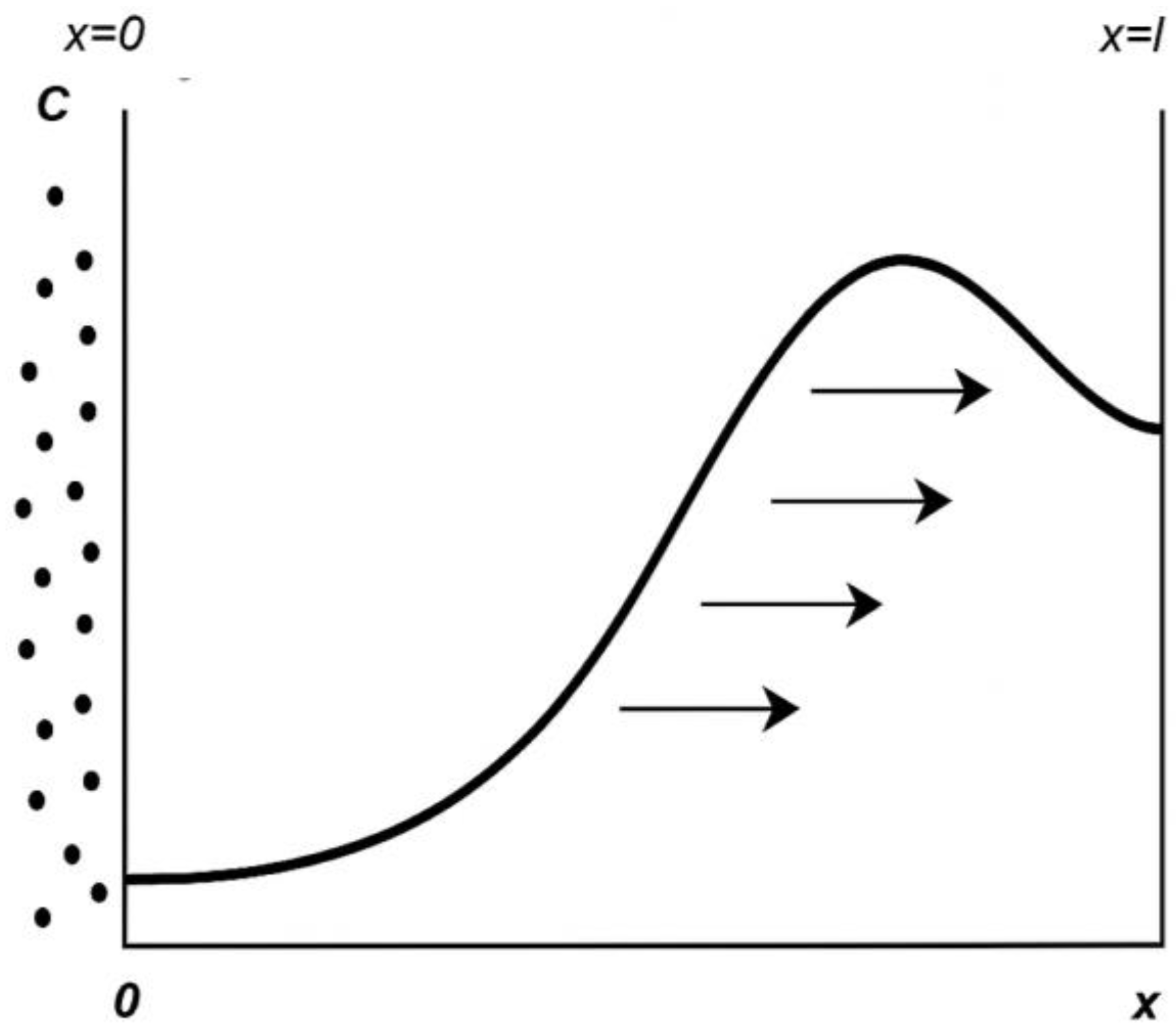
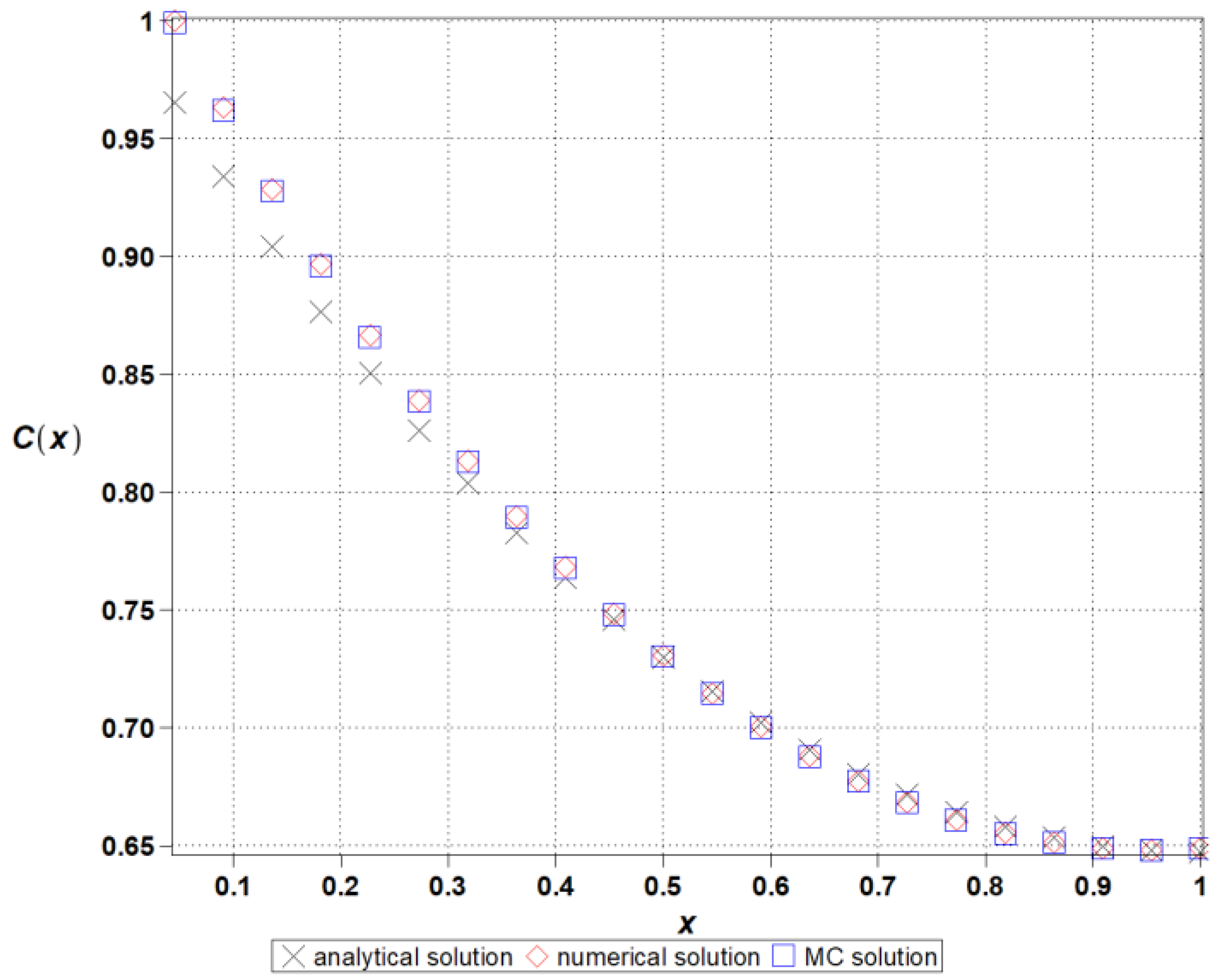
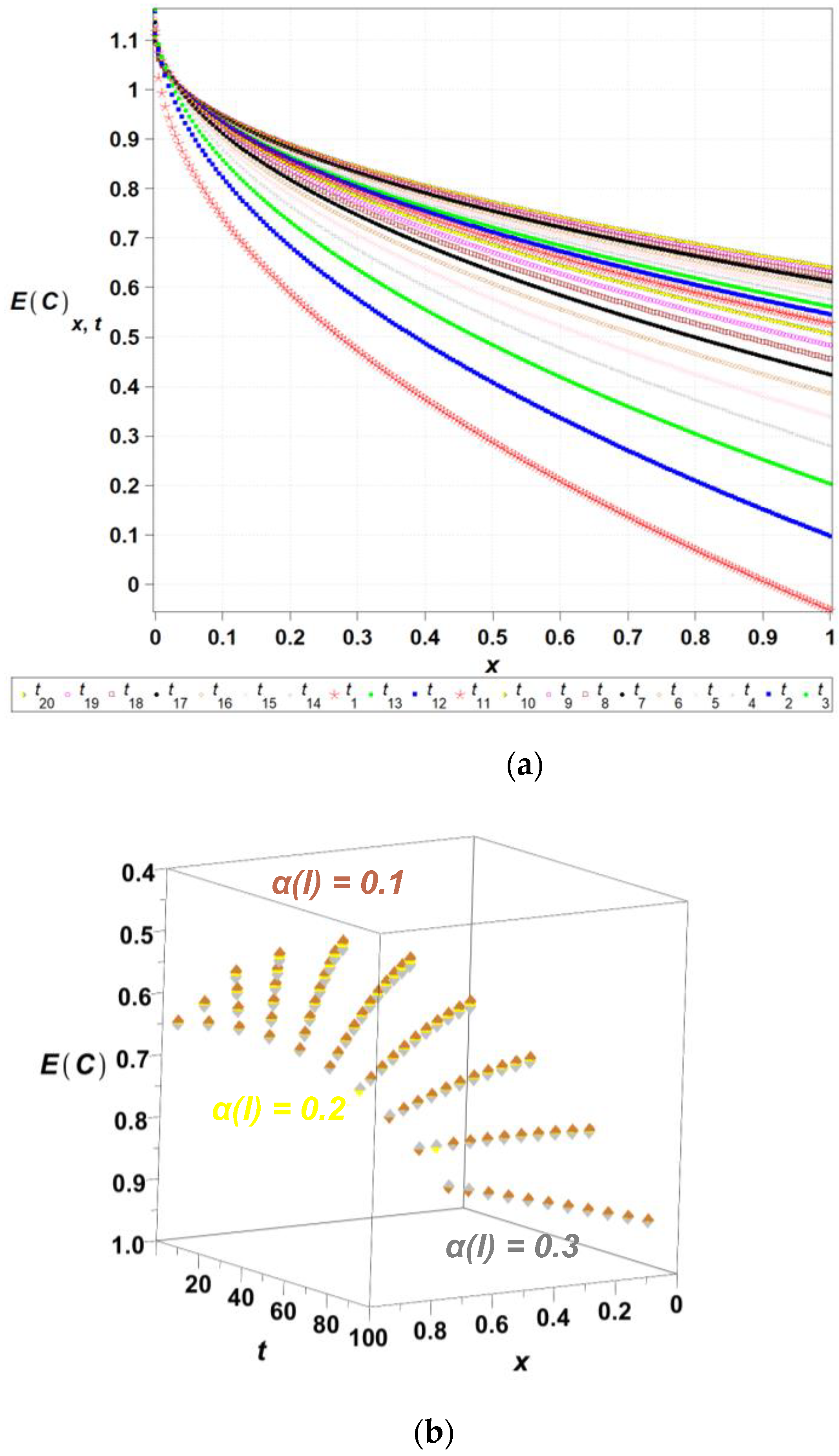

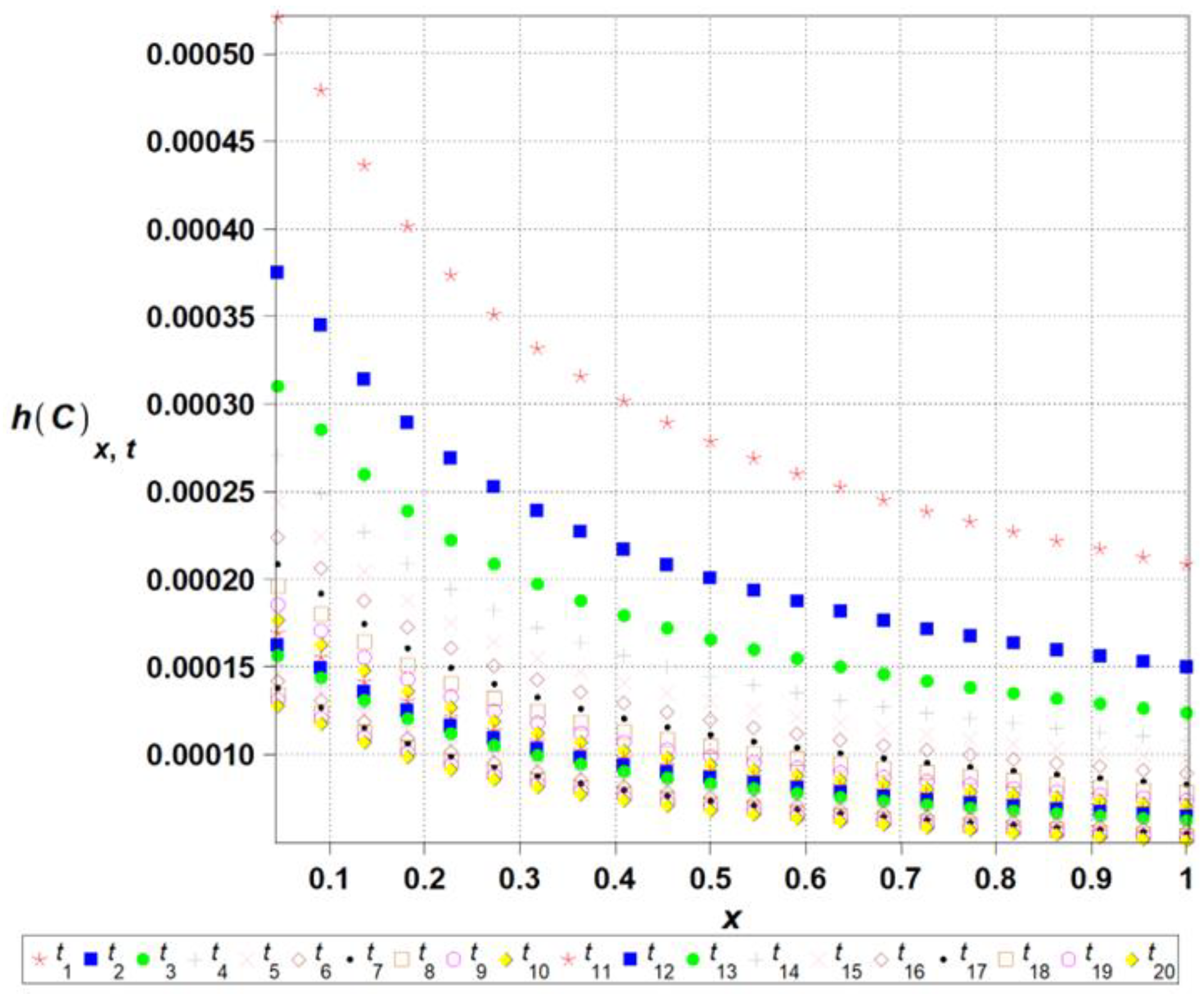
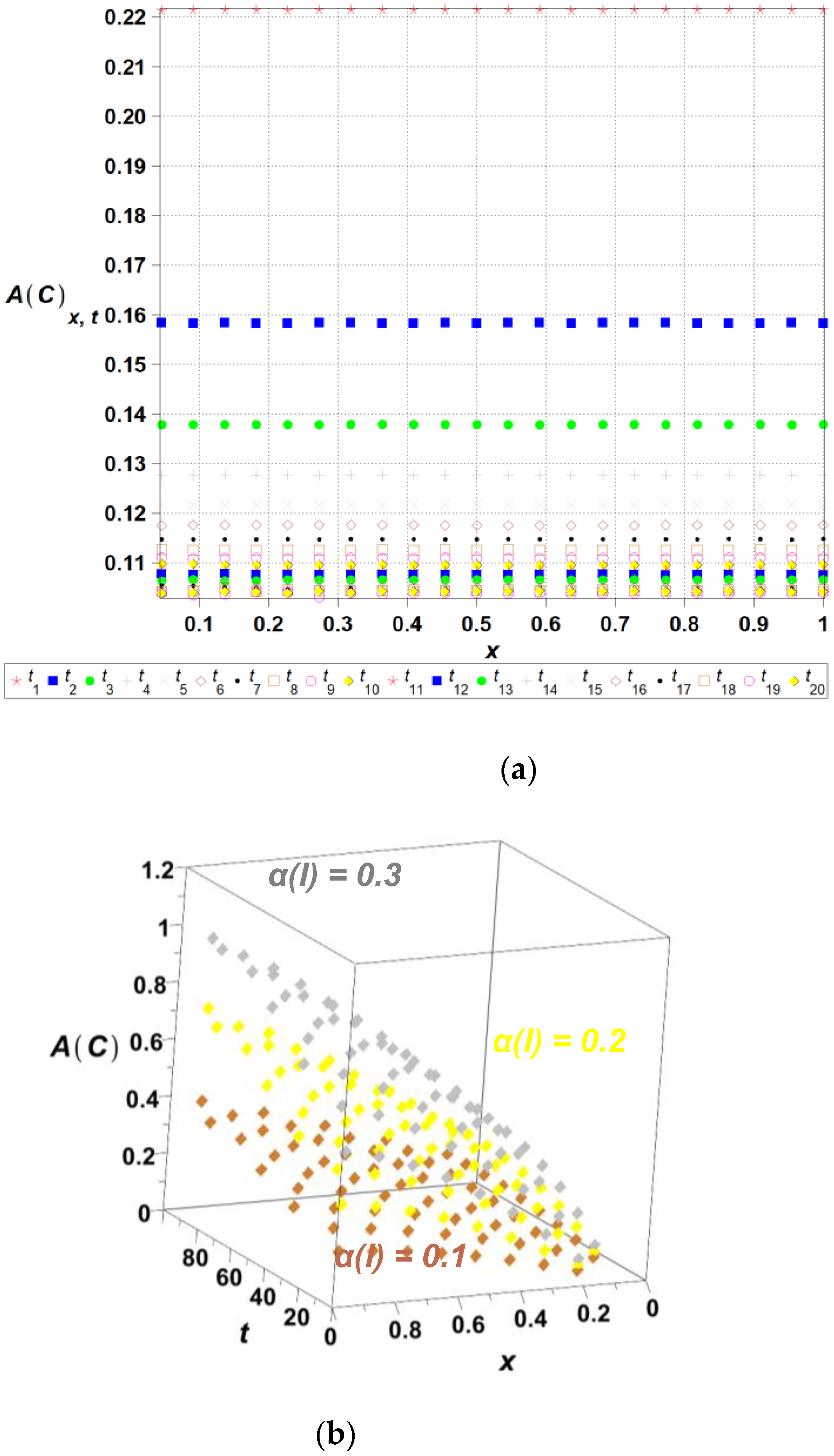

| , Δt |
|---|
| for i = 1 to n do compute for m = 0 to N do compute for k = 0 to 4 do compute estimate , end do end do end do |
| Symbol | Meaning |
|---|---|
| x | Spatial coordinate (position) |
| t | Time variable |
| ω | Element of the probability space |
| ℓ | Total length of the diffusion domain |
| ℓ(⋅) | Uncertain input function or parameter, modelled as random variable |
| C(x,ω) or C(x,ω,t) | Concentration as a function of space, randomness, and time |
| Ci | Approximation of concentration at the ith node |
| Δ | Grid spacing in the finite difference scheme |
| C0, C1 | Boundary concentrations at x = 0 and x = ℓ |
| b(ω) | Random parameter (e.g., uncertain channel length) |
| δ | Histogram bin width used for entropy calculation |
| ε | Perturbation parameter used in Taylor series expansion |
| E[⋅ ] | Expected value |
| Var[⋅ ] | Variance |
| CoV(⋅,⋅) or α(⋅) | Coefficient of variation |
| StD(⋅,⋅) | Standard deviation |
| A(⋅,⋅) | 3rd probabilistic moment—skewness |
| K(⋅,⋅) | 4th probabilistic moment—kurtosis |
| R(⋅,⋅) | Uncentered autocovariance function of a stochastic process Xt |
| μm(⋅,⋅) | mth probabilistic moment |
| h | Shannon entropy |
| p(b) | The probability density function of the random variable b |
| A | A Gaussian random variable used in the time series |
| SFDM | Stochastic finite difference method |
| RFM | Response function method |
| MAPLE | Symbolic computing system used for implementing the algorithm |
| 1. Input: E(l), α(l), Δt, total time steps n, number of moments m = 4 |
| 2. For i = 1 to n: a. Compute current time ti = t0 + (i–1) · Δt b. For each stochastic coefficient Am(ti), compute: i. Expectation E[Am] ii. Variance Var[Am] c. Solve boundary value problem via SFDM d. For k = 0 to m: i. Compute central moment μk(C(x,ti)) ii. Estimate histogram of output variable b iii. Compute entropy h(C(x,ti)) using histogram probabilities |
Disclaimer/Publisher’s Note: The statements, opinions and data contained in all publications are solely those of the individual author(s) and contributor(s) and not of MDPI and/or the editor(s). MDPI and/or the editor(s) disclaim responsibility for any injury to people or property resulting from any ideas, methods, instructions or products referred to in the content. |
© 2025 by the authors. Licensee MDPI, Basel, Switzerland. This article is an open access article distributed under the terms and conditions of the Creative Commons Attribution (CC BY) license (https://creativecommons.org/licenses/by/4.0/).
Share and Cite
Kamiński, M.; Ossowski, R.L. Application of Shannon Entropy to Reaction–Diffusion Problems Using the Stochastic Finite Difference Method. Entropy 2025, 27, 705. https://doi.org/10.3390/e27070705
Kamiński M, Ossowski RL. Application of Shannon Entropy to Reaction–Diffusion Problems Using the Stochastic Finite Difference Method. Entropy. 2025; 27(7):705. https://doi.org/10.3390/e27070705
Chicago/Turabian StyleKamiński, Marcin, and Rafał Leszek Ossowski. 2025. "Application of Shannon Entropy to Reaction–Diffusion Problems Using the Stochastic Finite Difference Method" Entropy 27, no. 7: 705. https://doi.org/10.3390/e27070705
APA StyleKamiński, M., & Ossowski, R. L. (2025). Application of Shannon Entropy to Reaction–Diffusion Problems Using the Stochastic Finite Difference Method. Entropy, 27(7), 705. https://doi.org/10.3390/e27070705






